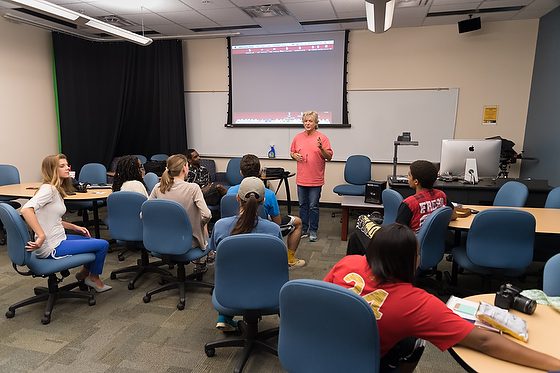| Robin Nelson speaks to the photojournalism class at Kennesaw State University on Thursday, June 16, 2016. [Nikon D5, Sigma 24-105mm f/4 DG OS HSM Art Lens, ISO 3200, ƒ/4, 1/100] |
Clay Asbury, lecturer for photojournalism at Kennesaw State University, asked Robin Nelson and me to speak to his photojournalism class.
Clay has been a working professional, but now since his role is that of faculty, he knows that the students will not listen to him as much as professionals working at the moment in the industry. A working pro is why he asked Robin and me to share our work and tips with the students.
There needs to be a connection between what students learn in the classroom and the profession.
When industry professionals connect with a classroom, they cannot only share with students the skills they need but serve as role models and inspire students to reach for the moon. Think about what you wouldn’t have given to get a glimpse of the natural world when you were a student.
Today’s Journalism schools are not the same as yesterday’s curriculum. Programs are changing to prepare the students to be cross-trained in writing, design, video, audio, and photography w, falling under the purpose of storytelling. Often these programs are now being renamed to media storytelling or some variance.
 |
| Stanley talks to the students about needing to have their images evoke emotions in the audience. [Nikon D5, Sigma 24-105mm f/4 DG OS HSM Art Lens, ISO 2500, ƒ/4, 1/100 photo made by Robin Nelson] |
I shared with the students the importance of visual literacy. Not so much the technology of making a photo but the understanding of body language and how composition can help convey emotions and pull the audience into the story through imagery–moving and stills.
I talked about how I review portfolios because I hire visual communicators for projects regularly. I wanted them to know I need to have images that communicate a message and not just cool pictures.
I talked to the students about dissecting photos. [link to the blog on topic] I told them that storytelling must involve conflict. [link to the blog on the topic] I also talked about the stages of composition photographers go through. [link on blog post]
 |
| Robin Nelson brought the class into a close circle and took questions from the students. [Nikon D5, Sigma 24-105mm f/4 DG OS HSM Art Lens, ISO 2200, ƒ/4, 1/100] |
I agreed to do this for no pay more than just paying it forward. Other pros helped me, but this is just creating competition.
If pros do not take the time to help students have a good foundation for entering the profession, those students will damage the industry.
I have watched so many college students and people who buy camera gear and are self taught help to destroy the industry before they must quit because they cannot make a living any more.
I want the new professionals to do things right so that the clients we all serve are excited to hire visual communicators over and over. But unfortunately, so many do such a lousy job that those who hired them want nothing to do with visual communicators again. They figure they can do the work themselves better than any pro.
Newbees have trouble pricing their work to pay their bills over time. The pricing problem is because they don’t know business practices.
Because they don’t charge realistic prices, those clients think that since they hire someone before for a specific rate, they can get professional work for that rate. Sadly there is another crop of newbies who also don’t know good business practices, and slowly, over time, the newbies leave the industry because they cannot pay their bills and erode the prices for those who were charging more of a livable wage.
I also know that I cannot always do jobs for my clients over time. There will be conflicts in scheduling. I would love to have colleagues who are true professionals in all aspects of the industry so that I can refer my clients.
If you are starting, the best place to meet other pros and get those tips like these students to have in the classroom is through organizations like ASMP and NPPA. Join them for some of the reasons I have outlined here. There are many other reasons as well.
If you are a pro, take the time to mentor young professionals and students. It will only help the industry as a whole.


